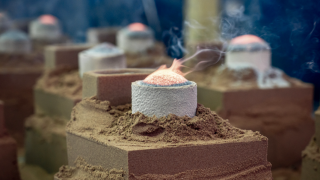
What causes shrinkage in casting?
Shrinkage occurs naturally when a liquid metal cools and becomes more dense. In casting this is manifest in two stages:
- Solidification shrinkage (or ‘liquid to solid shrinkage’) as the alloy changes from liquid to solid; and
- Patternmaker’s shrinkage (or ‘solid shrinkage’) as the solid metal cools to ambient temperature.
What is the danger of shrinkage?
Shrinkage must be managed throughout the casting process, as it can result in castings with defects including:
- poor dimensional accuracy
- aesthetic damage
- structural or technical weakness
How to minimise shrinkage
The right pattern
The mould which provides the cavity for molten metal must be precisely designed to compensate for patternmaker’s shrinkage. Technical design tools and casting expertise help Haworth Castings to predict the exact degree of solid shrinkage that will occur for a specified casting, so that the pattern can be made fractionally larger than the end product.
The right metal alloy
Alloys have different characteristics as they cool, which will affect shrinkage. Some alloys solidify quickly and predictably from the mould walls inwards, so good geometry design can take account of thermal gradient patterns to avoid internal shrinkage. Unpredictable alloys can also solidify in random internal areas, which must be carefully managed. Choosing the right alloy for your casting is a careful balance of factors, upon which we are happy to advise.
A good running system
The gating and riser system for pouring metal into the mould must be carefully designed to take account of the order in which areas will cool, so that the casting is fully fed with alloy and will continue to draw molten metal in the early stages of cooling. At Haworth Castings we use the latest simulation technology to optimise the running system for each casting.
The right pouring temperature
Liquid shrinkage may increase if the temperature of the poured alloy is too high. Too low, and the feeding capacity of the risers may fail, restricting the flow of metal. Our foundry team take account of the ambient temperature as well as the thermal properties of the metal when calculating exactly how to pour each casting.
Good casting structure
Careful design can ensure the casting cools evenly, reducing hotspots and therefore helping to manage shrinkage. If the geometry of the casting prevents directional solidification from occurring naturally, items such as chills can be used to promote optimal cooling. Haworth Castings has considerable experience and digital tools to help in good casting design.
How to check for shrinkage
Every casting must meet exacting specifications in terms of its mechanical properties, dimensional accuracy, aesthetics and tensile strength.
At Haworth Castings we offer UKAS approved independent testing and inspection services to meet the most demanding specifications for sand and gravity die castings. We perform visual inspections, as well as spectrographic atomic absorption and non-destructive testing, so you can be assured that our castings are free from shrinkage defects.
Expert shrinkage management from Haworth Castings
Haworth Castings has over 60 years’ experience in producing precision sand castings to demanding industries including defence, aviation and safety-critical industries. We are expert in managing shrinkage to produce high quality sand castings for every customer.
Please get in touch to find out more, please contact Haworth Castings on 01794 512685 or email [email protected].